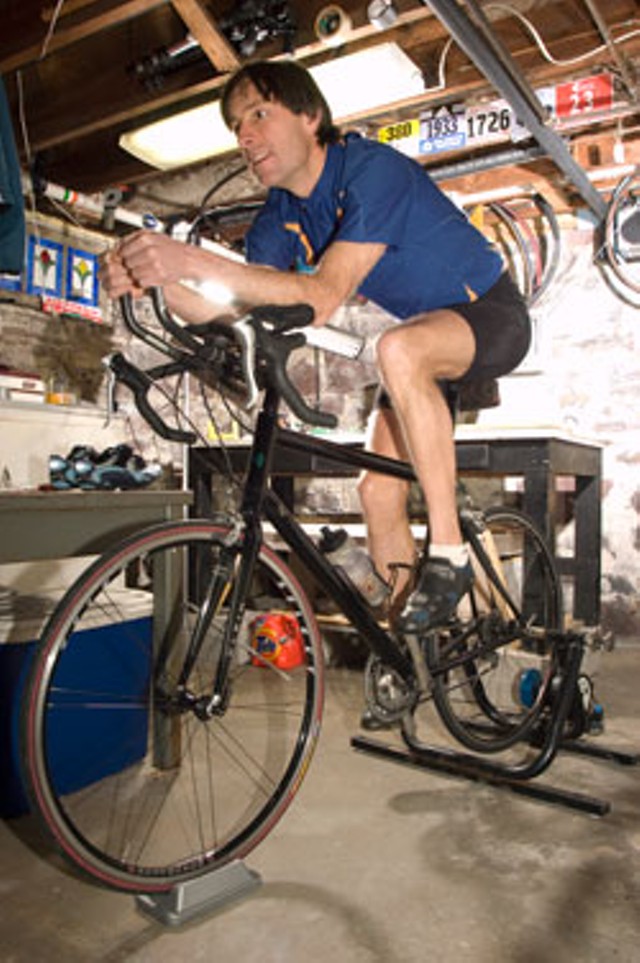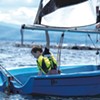Published January 21, 2009 at 6:02 a.m.
Adam Osekoski was living in a Boston suburb when he and his wife, Stephanie, decided to take a weekend trip to Vermont for a triathlon pilgrimage. He’d been reading about a Waitsfield bicycle-fitting shop called Fit Werx that caters to cyclists and people such as Osekoski himself, an amateur triathlete who has competed in four Ironman competitions.
“We got a room at a B&B and spent the day at the shop,” recalls Osekoski, now 37, a salesman for a specialty ceramics company. “We woke up in the morning and looked at housing and prices in the newspaper. For us, living near a major metropolitan area, seeing the cost of living, the commuting, you wake up and say, ‘What am I doing with my life?’”
The Osekoskis decided to move to Vermont in 2005, attracted by the outdoorsy lifestyle and the training grounds offered by the Green Mountains, Lake Champlain and miles of running trails. Adam found a growing community of competitive triathletes, as well as races that take advantage of the state’s mountains and lakes. Now president of the Green Mountain Multisport club, he’s planning to buy a mountain bike to participate in a newly created off-road triathlon in Essex this summer.
“We’re endurance junkies,” Osekoski says of the growing population of Vermont athletes who compete in the race, which combines swimming, bicycling and running.
While there are no statistics tracking the number of Vermont triathletes, local competitors say anecdotal evidence points to a jump in new participants during the past few years. To be sure, the increase coincides with a national surge in the competition’s popularity. According to the website of USA Triathlon, the sanctioning authority for more than 2000 races, the organization’s membership ballooned from 19,060 in 1999 to 96,000 in 2007.
The quality of Vermont triathletes tends to be competitive, even though fewer people are involved in the sport than in larger states such as California or New York, Osekoski says. Three to five of his club’s roughly 35 members have qualified annually for Ironman Hawaii, which Osekoski describes as “the Super Bowl of races.”
An Ironman competition combines a 2.4-mile swim, a 112-mile bike ride and a marathon. The grueling race can take anywhere from eight to 16 hours, depending on the ability of the athlete, who must complete the legs without breaks. The switch between segments, called the “transition,” is a race in itself. Competitors hone techniques for slipping out of their wetsuits and into bike shoes, or flinging off helmets and bike shoes to exchange them for running shoes, as fast as they can without losing time.
In Vermont’s triathlon races, “instead of 1000 competitors, there are maybe 100 or 150, but the top 10 people do well at national races,” Osekoski says.
One of those is Kim Loeffler, a professional triathlete who runs Burlington’s On Track health club and physical therapy business with her husband Brian. She’s also a member of the Green Mountain Multisport Club and races in Ironman competitions such as those in Hawaii and Lake Placid. The couple moved here from Boston in 2001 to start their business, partly because of relatives nearby and partly because they sought a town with an outdoor lifestyle where Loeffler could train for races.
At the time, however, the triathlon scene was almost nonexistent, she remembers. The Green Mountain Multisport club hadn’t been formed yet, and finding training partners could be tough. “When we moved here, there wasn’t that much of a tri community,” Loeffler says. “I had three or four friends. That was it. I’ve seen it really grow.”
That growth is snowballing, attracting new races. Last June, for the first time, national race organizer Xterra sponsored an event in Vermont. Xterra takes the triathlon formula and throws it off road, with mountain biking instead of road cycling and trail running instead of a road race.
Mark Brislin, assistant director of the Essex Junction Recreation Department, is another “endurance junkie”; he started racing in Xterra competitions four years ago when he lived in New Hampshire. After moving here to work for the rec department, Brislin approached Xterra about bringing one of its races to the Burlington area.
The number of entrants surprised him: “We had hoped for 70 people and we had over 100 people,” Brislin says. Most of the racers were locals, although a few came from as far as Costa Rica and Hawaii. The race, held at Indian Brook Reservoir in Essex, included a .75-mile swim in the reservoir followed by a 10-mile mountain bike ride in the park, mostly on single track with some rocky and steep terrain. To finish, competitors ran four miles around the reservoir.
Next year, Brislin predicts, the race will attract between 115 and 120 competitors. Xterra plans to sponsor a second Essex race as well as a new July race at Sugarbush, which may get more competitors from around the U.S., Brislin suggests.
Even though the sport pits individuals against each other, triathletes say training partners, who offer support, ideas and encouragement, are invaluable. The local boost in participation makes them easier to find.
“There are always people out running and biking,” Brislin says. “You’re never at a loss to find people to go out biking with.”
Thomas Dunn found one training partner at the top of the Appalachian Gap, the pass near Waitsfield that’s been termed a “mountain monster” by Outside magazine. After riding the 40 miles from his home in Burlington, Dunn was taking a break at the summit when a fellow cyclist asked him about his training plan. The two compared notes and found they both lived in the Queen City and competed in triathlons.
“Turns out he lives five houses away from me,” says Dunn, who placed sixth in last year’s Esprit Triathlon, an Ironman distance race in Montréal. The two now occasionally pair up for cycling training in the summer.
Dunn says he and his wife, Bethany Whitaker, who also competes in triathlons, relocated to Burlington from Hong Kong after he visited and participated in the YMCA’s annual swim across Lake Champlain.
“It was a beautiful day; I saw across the lake, and I thought, ‘We have to move here,’” he says.
So, for a triathlete, what’s not to like about training in Vermont?
One word: winter. “It gets really hard,” Loeffler says.
Because bicycling in the winter is dangerous, most triathletes move into their basements. Using a metal contraption called a bicycle trainer, they set up their racing cycles in a stationary position. Then they ride for several hours — usually while watching DVDs or television.
“I would put in 15 hours a week. That’s a lot of TV shows,” Loeffler says. “Now I go away.” Because her professional season can begin as early as January — unlike amateur competitions, which start in May — she leaves in February to train for six weeks in a warmer climate. This year, Loeffler plans to head for Tucson and race at the end of February in a duathlon, an event with a running leg followed by cycling and more running. At the start of April, she’ll compete in a half-marathon, and then leave for Ironman China.
For athletes with full-time jobs outside the sport, globe-hopping isn’t an option. Many amateurs take advantage of Vermont’s snow sports to keep in shape during the winter, Loeffler says.
“And when the weather gets nicer, they get outside,” she adds. “There’s Lake Champlain, lots of places for open-water swimming, lots of trail roads and dirt roads. There are six mountain passes, which makes for really good, challenging cycling. In the summer it ranks in the top four best places to train.”
And that suits the high-endurance folks who have migrated to the Green Mountains just fine.
More By This Author
About the Artist

Matthew Thorsen
Bio:
Matthew Thorsen was a photographer for Seven Days 1995-2018. Read all about his life and work here.
Matthew Thorsen was a photographer for Seven Days 1995-2018. Read all about his life and work here.
Speaking of...
-

UVM Swimming and Diving Overcomes Budget Cuts to Win Conference for the First Time in Its History
Mar 13, 2024 -

Two Vermont Teens Take On the Cross-Country Junior National Championships
Mar 6, 2024 -

Youth Soccer Comes of Age in Vermont, but the Playing Field Is Hardly Level
Nov 1, 2023 -

'We Must Act Now': Burlington Council Passes Resolution on Drug Crisis, Public Safety
Oct 11, 2023 -

In a Classic Vermont Mountain Road Rally, Winning Takes Precision and Smarts, Not Speed
Sep 20, 2023 - More »
Comments
Comments are closed.
From 2014-2020, Seven Days allowed readers to comment on all stories posted on our website. While we've appreciated the suggestions and insights, right now Seven Days is prioritizing our core mission — producing high-quality, responsible local journalism — over moderating online debates between readers.
To criticize, correct or praise our reporting, please send us a letter to the editor or send us a tip. We’ll check it out and report the results.
Online comments may return when we have better tech tools for managing them. Thanks for reading.














































